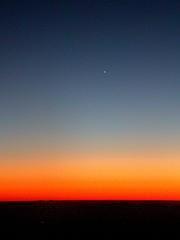
Photo by kariobinja.
I realize that only a small set of people enjoy poetry (if you discount song lyrics).And an even smaller set of people enjoy poetry about aging.
Nevertheless, as a retired English teacher now in midlife, I find myself thrilled when I find a poem that explores age-related themes.
I recently learned that Henry Wadsworth Longfellow (1807-1887) wrote a fragment of a dramatic poem, featuring artist / inventor Michael Angelo.
Longfellow's unfinished manuscript was found in his desk after his death at age 75.
Michael Angelo, contains themes about aging, memory, legacy, and time--which all interest me a great deal now that I've hit midlife.
Here are a few lines from the section entitled "The Last Judgment":
Longfellow (or at least his poem's persona) implies that the evening star is more fair. Why did I conclude this? Longfellow only uses 16 words to describe the morning star. In contrast, he uses 36 words to use the evening star--a symbol of late life.
...Which is more fair,
The star of the morning, or the evening star?
The sunrise or the sunset of the heart?
The hour when we look forth to the unknown,
And the advancing day consumes the shadows,
Or that when all the landscape of our lives
Lies stretched behind us, and familiar places
Gleam in the distance, and sweet memories
Rise like a tender haze, and magnify
The objects we behold, that soon must vanish.
I recommend reading the entire poem, even though some passages convey a bit of sorrow and regret. Longfellow conveys a richness when observing late life. I find value in the perspective of a mature poet.
Related:
The Oak: A Poem
Soap: An Aging Image

